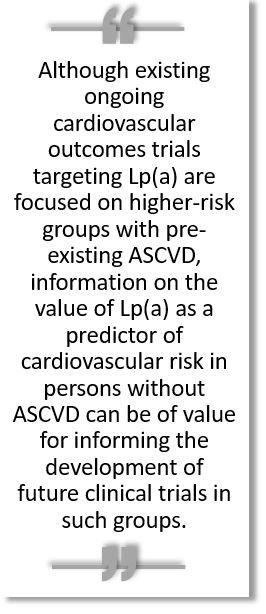- CDC
- Heart Failure
- Cardiovascular Clinical Consult
- Adult Immunization
- Hepatic Disease
- Rare Disorders
- Pediatric Immunization
- Implementing The Topcon Ocular Telehealth Platform
- Weight Management
- Monkeypox
- Guidelines
- Men's Health
- Psychiatry
- Allergy
- Nutrition
- Women's Health
- Cardiology
- Substance Use
- Pediatrics
- Kidney Disease
- Genetics
- Complimentary & Alternative Medicine
- Dermatology
- Endocrinology
- Oral Medicine
- Otorhinolaryngologic Diseases
- Pain
- Gastrointestinal Disorders
- Geriatrics
- Infection
- Musculoskeletal Disorders
- Obesity
- Rheumatology
- Technology
- Cancer
- Nephrology
- Anemia
- Neurology
- Pulmonology
Elevated Lp(a) Level Increased ASCVD Risk Regardless of Age, Sex, Race/Ethnicity in Pooled Primary Prevention Cohort
Elevated lipoprotein(a) was independently associated with increased ASCVD risk across primary prevention subgroups including among those with LDL-C of 70 mg/dL.
Nathan Wong, PhD
UC Irvine
UC Irvine

The risk for long-term atherosclerotic cardiovascular disease (ASCVD) events posed by elevated levels of lipoprotein(a) (Lp[a]) was found similar across age, sex, race/ethnicity, and CVD risk categories in a large pooled multiethnic sample representing 5 landmark primary prevention cohorts. Over the mean 2 decades of follow-up, the predictive value of higher levels of Lp(a) for adverse CV events was strongest in study participants with vs without diabetes, according to the new study results, and Lp(a) percentile was individually predictive of myocardial infarction (MI), revascularization, stroke, and death from coronary heart disease (CHD).
The findings, published online April 15, 2024, in the Journal of the American College of Cardiology, are based on data for Lp(a) and ASCVD outcomes from 5 US prospective studies: MESA (Multi-Ethnic Study of Atherosclerosis), CARDIA (Coronary Artery Risk Development in Young Adults), JHS (Jackson Heart Study), FHS-OS (Framingham Heart Study-Offspring), and ARIC (Atherosclerosis Risk In Communities).
"Our study represents the largest and most ethnically diverse US population-based pooled cohort analysis of Lp(a) in relation to ASCVD events in primary prevention groups with significant representation of both female and Black participants," researchers led by Nathan Wong, PhD, Director, UCI Heart Disease Prevention Program at the University of California Irvine, wrote in JAAC.

"Although existing ongoing cardiovascular outcomes trials targeting Lp(a) are focused on higher-risk groups with pre-existing ASCVD, information on the value of Lp(a) as a predictor of cardiovascular risk in persons without ASCVD can be of value for informing the development of future clinical trials in such groups," stressed Wong and colleagues.
The investigators created a pooled cohort from the 5 prospective studies of 27 756 individuals aged 20 to 79 years (mean age 51.2 years) with a measure of Lp(a) and without preexisting ASCVD at the time of measurement. Of the population, 55% were women, 35.6% were Black, 4.7% Hispanic, and 2.5% Asian. Participants with diabetes comprised 7.6%.
Within each study cohort, Wong eg al categorized Lp(a) by percentile: <50th (reference), 50th to <75th, 75th to <90th, and =/>90th.
The primary ASCVD outcomes were nonfatal and fatal MI and stroke, revascularization, and CHD death that occurred following the examination in each study at which Lp(a) levels were determined.
FINDINGS
Overall, 82.4% (n = 22 871) of participants were at low-intermediate ASCVD risk, 17.6% (n = 4885) were at high risk, and 7.6% (n = 2100) had DM, according to study findings.
ASCVD by Lp(a) percentile. Compared with persons with Lp(a) in the <50th percentile, those in the 50th to <75th, 75th to <90th, and =/> 90th percentiles had higher adjusted HRs for incident ASCVD of 1.06 (95% CI, 0.99-1.14), 1.18 (95% CI, 1.09-1.28), and 1.46 (95% CI, 1.33-1.59), respectively. Women and participants identified as Black were more likely to have higher levels of Lp(a). HRs were similar comparing those participants in low-intermediate–risk vs high-risk groups (Pinteraction = .88), but HRs were higher in those persons with vs without DM (Pinteraction = .006). Patients with DM who had Lp(a) levels equal to/greater than 90th percentile had a nearly 2-fold greater risk of incident ASCVD (HR 1.92; 95% CI, 1.50- 2.45).
Similar ASCVD risk. HRs for incident ASCVD were progressively higher with higher Lp(a) levels for both men and women and among all race and ethnicity groups, although results were not significant for Asian and Hispanic participants, given small sample sizes and number of events.
Wong and colleagues reported further finding no significant differences in the relationship of Lp(a) and ASCVD event risk between groups identified by sex (Pinteraction =.66) and race or ethnicity (Pinteraction = .43). When the investigators analyzed risk according to category of LDL-C, they found higher Lp(a) levels consistently associated with greater ASCVD event risk across LDL-C categories (Pinteraction = .74), but especially in those persons with LDL-C =/> 70 mg/dL. Similar relationships of Lp(a) with ASCVD events were observed according to presence of obesity (Pinteraction = .34), smoking (Pinteraction = .57), and hypertension (Pinteraction = .63)

For the individual endpoints of MI, stroke, revascularization, CHD death, and non-CHD mortality, Wong et al reported that higher Lp(a) levels were significantly associated with 14%, 28%, and 66% higher risks of incident MI, respectively, compared with <50th percentile Lp(a) levels. Only Lp(a) levels =/> 90% were significantly associated with incident stroke and CHD death. Relationships were most pronounced for MI and revascularization (HR 1.66 and 1.68, respectively; both P <.001) comparing those with highest vs lowest percentile of Lp(a).
“Our analysis demonstrates in the primary prevention setting that higher levels of Lp(a) consistently predict future ASCVD events down to an LDL-C of 70 mg/dL,” a finding that supports the rationale for screening Lp(a) in this setting and also recent recommendations for universal screening of Lp(a), wrote authors. "Further studies in large-scale real-world cohorts, including from medical insurance databases, should also be conducted to provide additional confirmation,” they concluded.
